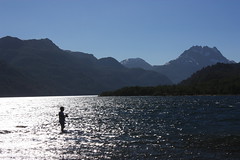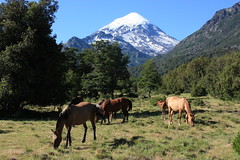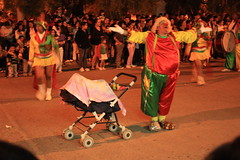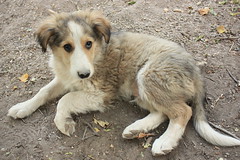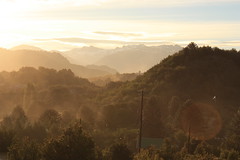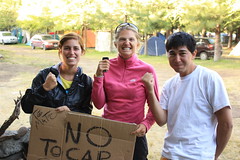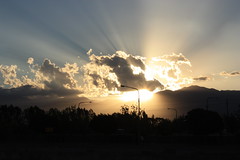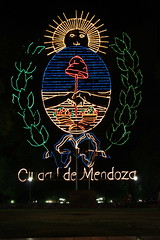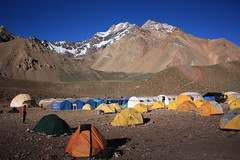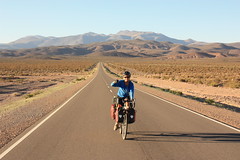
The landscape to the south and west of San Rafael returns very quickly back to desert so we had another very long day ahead, with the next habitation over 130km away. We had handicapped ourselves with a hangover from the night before and had left Sandy and Doug's very late. By midday we had covered just 25km. For lunch, we were lucky to find a services in the desert, although it appeared to be run by
Cathy Bates in 'Misery'. We did however manage to draw our biggest crowd yet from the other motorists, keen to hear about the trip. At least we now have sufficient miles under our belts for the journey to sound hard enough to impress a school child as well as a gaucho (each end of the spectrum). We are going to be very disappointed back in the UK when we aren't teated like celebrities in every service station and small village. On leaving the services, we felt that anything less than completing all 135km to the next pueblo would disappoint our crowd, so we made El Sosneado that night - our new longst day! We stopped for the night in the back garden of a restaurant who agreed that if we ate there, we could camp out back for free. It was an odd set-up with lots of dogs and pups, car parts strewn everywhere, a chatty 10 year old called Martin, and a sheep wearing hairclips.

We headed for Malargue the next morning, expecting to have a rest the following day, but we had an exceptional morning, covering the 51km by 10am so we decided to have a lazy afternoon and head off the next day. Malargue is a launch point for the local ski resorts so looked a bit alpine in some respects. The town has a backdrop of snow covered mountains and the routes in and out were a welcome sight after the flat plains surrounding San Rafael.
The day we left Malargue was not a day to bother getting out of bed. The scenery at the start was beautiful; the route winding slowly upwards through small volcanic cones just 100m higher than the road. In the distance to the east, you could see the northern reaches of a national park containing the densest collection of volcanic cones in the world, some huge, some tiny. Just after reaching the top of the pass however the road deteriorated into ripio again and our progress became a crawl. To make matters worse, a headwind picked up, shortly followed by stinging clouds of dust and even small stones picked up by the gusts. To round the day off, Catherine came off the bike on a nasty downhill section of deep gravel. The image of Catherine lying on the road with her bike on top of her is not a sight I want to see again in a hurry. I'm amazed at how well she took it, beacuse she had scraped the skin off her right arm, knee, and both hips. I'm not a nurse, and by the time I'd finished my 'field dressings' Catherine looked like Mr Bump soaked in betadine, so we stopped at the next village with a doctor, to get the grit removed from the cuts. The curative powers of beer and grilled chicken worked their magic and we managed to spend a very enjoyable evening with a touring English couple, Jen and Seb, in possibly the most basic accommodation outside of Bolivia and Tibet. This was clevery counter-balanced however by the cheering sight of the owner, a small greying man wearing top-to-toe shiny man-made fabrics, looking a little like a darts player/jockey hybrid.
In cosmic payment for the horrendous day before, the journey to Barracas was excellent. The road led gently downhill for nearly 60km, through a wide river delta between flat high ridges, crested with lots of volcanic cones (the southern reaches of the same park we saw the day before). This road really isn't travelled much and we had the whole valley to ourselves for most of the time, giving it a slight 'lost valley of the dinosaurs' air. By lunchtime the wide river delta had narrowed to a deep gorge where the lava from the volcanoes had redirected the flow, and we were now cycling through charred and blacklened flavafields. The road became ripio again and this time, to avoid a repeat of yesterday's accident, we asked a
man with a truck to take us over the last 10km of gravel and he dropped us off in the next small village called Buta Ranquil. Catherine went off to find a shop whilst I fixed a flat tyre. She was gone a while when a man in a truck pulled up and said ' Catherine's having a BBQ at our house' and started loading our bags into his truck. When I got out at the top of the hill, Catherine was indeed holding a glass of wine, eating a BBQ at their house. We had just met
the friendliest family in Argentina. They lived next to the shop which was closed for siesta, and when they saw Catherine walking away, they asked what she needed. When she explained we needed water and some more food they just said 'we have food and beer here, have dinner with us'. They also turned out to be the booziest family in Argentina and they plied us with beer wine (and the dreaded Fernet) until we couldn't walk straight. They were so kind and even asked us to stay the night, but we had to press on so we took the inadvisable option of cycling off into the mountains drunk, just as it was getting dark. On the plus side we did achieve a new top speed on the bike computer ...
69kmphWe didn't notice the strong winds at the start of the day and we seemed to be going pretty well all the way to Buta Ranquil, an isolated mining town in the shadow of a huge volcano. We stopped for some breakfast at a hotel. Whilst inside, we heard the wind outside turn into a raging hurricane and the owners suggested staying the night. We thought this was a ploy to drum up business. We weren't even put off when we went outside to find the bikes on the floor, and I had to walk three blocks before I found my helmet hat and gloves. We even thought it was novel that the wind could almost push you up a hill one minute but stop you dead in your tracks from trying to get down the other side. This continued for a few hours but ultimately the day was defined by the storm that followed. We rode up a ridge, very slowly into the wind, and saw some inky black clouds covering the high mountains in the direction we were heading. The wind got worse, we had to get off and push, and eventually the temprerature started to drop ... quickly. We found out later that the temperature had dropped from over 30 degrees to minus 18 in the space of just about 3 hours. The rain started and it felt like ice, so we had to stop at the nearest farmhouse to see if they could stick us in a barn for the night. They were a warm but nearly mute family of Gauchos, high-mountain livestock farmers known for ther love of hard stares and silence. They were, on the other hand, incredibly generous, and with possibly only 7 or 8 words spoken between us, they had warmed us up with maté tea and some toast, and had cleared a barn for us to sleep in. It was only when we went to bed that we realised that we were to share the barn with three dogs, a couple of goats, lots of hens and even a rooster (handy for those wanting an early start). The wooden and glass cabinet in the corner of the room containing a plastic figurine of Christ helped to drive home the whole
'Mary and Joseph' nature of the scene. To round off the night, a group of bikers from Santa Fe, stranded in the same pueblo, had heard about us from a neighbouring farmer, and popped round to see if we wanted to share some maté and coffee round at 'their barn'. They too were incredibly generous and we sheltered from the storm which had now turned to heavy snow, comparing routes and equipment.
For those planning a similar trip, some advice: If you ever see a cloud so funny that you have to stop and photograph yourselves, smiling in front of it, don't just continue to cycle towards it. It probably means something horrendous is on the way, like a hurricane, plummeting temperatures and heavy snow.
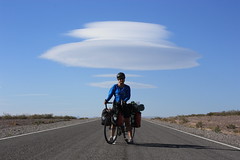
Inevitably we awoke with the rooster, thanked our Gaucho hosts and set off into snow covered hills on a cold windy morning. Conditions soon improved though and we were almost grateful for the snow as it provided us with an appropriate
welcome to Patagonia. We had actually crossed the political border the previous day but the ridge of snow-capped peaks under a clear blue sky that greeted us just before the descent into Chos Malal seemed more fitting. In Chos Malal we stayed at a lovely hostel full of ... more dogs and cats, and with a lovely courtyard out back complete with parilla. We decided to test our parilla skills by introducing some of Doug's tips from his finca in San Rafael. The results were good but we spent most of the meal picking the kitten off the table and ignoring the circle of dogs, one of whom kept
offering us stones in trade for meat. This would be endearing but he put them in the salad. We also met a couple of Swiss guys travelling north from Patagonia, and the news from 'down south' doesn't sound too good; crowded, expensive, difficult to get accommodation now that it's high season, and a bit touristy. We're not sure we're ready for this after so long in empty roads, campsites and hostels.
Day 17: Capitain Montoya to El Sosneado - 134km
Day 18: El Sosneado to Malargue - 51km
Day 19: Malargue to Bardas Blancas - 66km
Day 20: Bardas Blancas to Barrancas - 119km
Day 21: Barrancas to 'The Nativity Scene' - 86km
Day 22: 'The Nativity Scene' to Chos Malal - 43km
